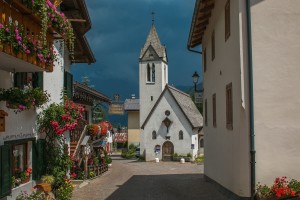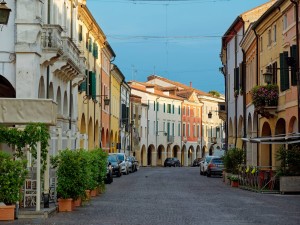
©Bigstock.com/Buffy1982
Venice. Verona. Padua. Vicenza. Treviso. Some of Italy’s biggest cities can be found in the Region of Veneto in northeastern Italy. In terms of population, it is the fourth largest in the country which makes sense due to these metropolises. However, beyond these popular tourist destinations there’s an abundance of insider tips that are frequently – and most certainly wrongly – overlooked. The private association “I borghi più belli d’Italia” is dedicated to the protection of these gems’ interests. The two Venetian provinces Belluno and Padua each have two of the most beautiful places of Italy showing off a delightfully different side of the region.
Province of Belluno
The largest province of Veneto by area has the lowest population density. Swaths of the UNESCO World Natural Heritage Dolomites cover this area and form a divine contrast to the comparatively cute, green Po Valley. The most beautiful places of the Province of Belluno most certainly make us of this scenic beauty, and there are exactly two of them.
Mel
Joining Trichiana and Lentiai, Mel (approx. 1,200 inhabitants) has been part of Borgo Valbelluna, a municipality newly formed in 2019, yet it is one of the most beautiful places of Italy in its own right. The earliest settlements date back to the 9th century BC. Finds from a nearby necropolis as well as many other interesting exhibits can be seen in the Archaeological Museum. Find testaments of Roman cultures – a wall plaque and a stone sarcophagus – near the baroque parish church, a highlight by itself thanks to paintings by Cesare Vecellio and Andrea Schiavone.
Narrow roads run through Mel, inevitably leading to the trapezoid main square lined with several grand palaces. Palazzo Zorzi, home of the town hall, welcomes you with impressive frescoes on the first floor. Villa Fulcis with its eponymous palace and wide park is among the province’s most imposing complexes. Don’t miss out on visiting Castello di Zumelle which was based on an old Roman fortification.
Sottoguda
Sottoguda (approx. 90 inhabitants) awaits you on the foot of the tallest Dolomite glacier, the Marmolata, at an altitude of about 1,250 m. Despite “only” being one of countless frazioni of Roccia Pietore, Sottoguda stands out by itself as one of the most beautiful places. One of the factors for this is the breathtakingly stunning nature around the Serrai di Sottoguda nature park with a spectacular canyon. Walking paths and hiking trails run through the protective area. Signs along the way tell stories of myths and legends. This area mostly belongs to ice climbers in winter.
Other highlights pertain to the prominently displayed Ladin folk culture celebrated on Thursday nights. They focus on Ladin art and culture, and on traditional regional cuisine. Old barns, the so-called “tabièi”, illustrate the traditional block construction. Three splendid alpine Gothic churches, the old wrought iron workshops and the centuries-old beech forest neatly cap off the Sottoguda experience.
Province of Padua
Find two UNESCO World Heritage Sites – the Botanical Garden of Padua and the buildings of the 14th century fresco cycles – in the province with the highest population density in all of Veneto. Plenty of small and medium-sized towns, such as the popular health resort Abano Terme and Este (home of the former noble dynasty who ruled over most of Emilia Romagna from the mid-13th to the late 18th century), offer many a surprise. And then, there’s the two most beautiful places in the Province of Padua that have their own distinctive charm.
Arquà Petrarca
Arquà was given the addendum Petrarca in 1870 to honour the great Italian poet and humanist Francesco Petrarca who spent the final years of his life here. It won’t come as a shock that Casa Petrarca, his old home, is one of the most popular sights of Arquà Petrarca (approx. 1,800 inhabitants). The lower rooms of the stately house with loggia, external staircase and small garden welcome you with a permanent photo exhibition. The upper floor, however, was fully covered in frescoes depicting the literary life of the poet, as commissioned by a later owner.
Petrarca’s home and the church of the Holy Trinity make up the (upper) village centre. The oratory, first documented in 1181, is endowed with several baroque altarpieces. Sadly, only very few of the older 14th century frescoes survived. The lower village centre features the slightly older parish church that was only given its current neo-Romanticism charm about 100 years ago. Inside you’ll find restored frescoes and Petrarca’s tomb. Several villas and palaces line your tour of this beautiful place.

©Bigstock.com/makam69
Montagnana
24 imposing hexagonal towers steady the massive medieval town wall surrounding Montagnana (approx. 9,300 inhabitants). This defence wall, mostly built between the 13th and the 14th century, protects several palaces and villas from different eras. Your tour will lead you past the noble residence Villa Pisani, Palazzo Giusti Chinaglia with its Venetian loggia, and the Gothic Venetian Palazzo Magnavin-Fioratti among many other buildings. Don’t sleep on the 16th century town hall and the imposing late Gothic cathedral with its late Renaissance additions. Castello di San Zeno, in contrast, dates back to the 13th century.
Putting the plethora of architectural styles aside for a bit, Montagnana is also home to genuine culinary bliss. The fine, high-quality ham Dolce di Montagnana is among the region’s most popular products. It is slightly sweeter than the well-known Parma ham and has very fine mottle. If you plan on visiting the region in autumn, you might want to check out the Palio dei 10 Comuni. This horserace, something like a smaller but just as nice version of the Palio di Siena, can be traced back to the 12th century and always takes place on the first Sunday in September.
Nature alone is reason enough to visit the most beautiful places in the provinces of Belluno and Padua as it serves as a wonderful, impressive backdrop for these fascinating villages. Architectural variety, massive walls, culinary treats and witnesses of days long past show many different sides of Veneto, one nicer than the next. Everyone will find something spectacular here, even beyond the big cities.